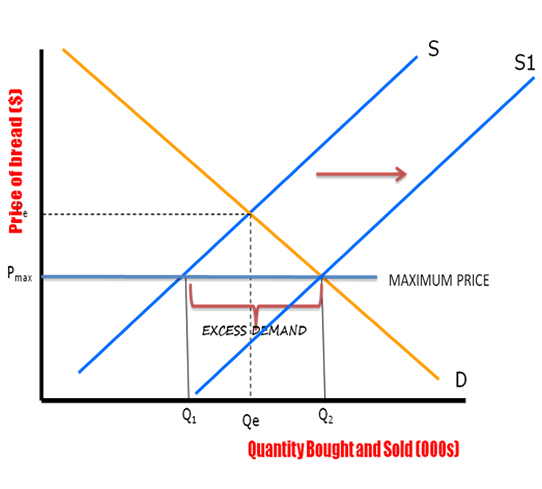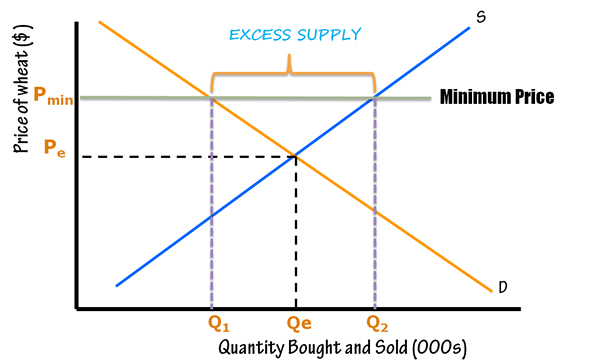GOVERNMENT INTERVENTION IN MARKET PRICES
Maximum Price or PRICE CEILINGS
In some markets, governments intervene to keep prices of certain items higher or lower than what would result from the market finding its own equilibrium price.
A price ceiling occurs when the government puts a legal limit on how high the price of a product can be. In order for a price ceiling to be effective, it must be set below the natural market equilibrium.
It is also known as maximum price.
Rent control is an example of a price ceiling, a maximum allowable price. With a price ceiling, the government forbids a price above the maximum. A price ceiling that is set below the equilibrium price creates a shortage that will persist.

For the price that the ceiling is set at, there is more demand (Q2) than there is at the equilibrium price. There is also less supply (Q1) than there is at the equilibrium price, thus there is more quantity demanded than quantity supplied i.e. shortage.
Impact of Price ceiling
Inefficiency: Inefficiency occurs since at the price ceiling quantity supplied the marginal benefit exceeds the marginal cost. This inefficiency is equal to the deadweight welfare loss.
Existence of black market: Due to demand exceeding the supply, there will be buyers who will be willing to purchase the good at a higher price. This will lead to existence of black market.
How can government correct this situation
Subsidies may be offered to the firms to encourage the production of such goods. However it involves an opportunity cost to the government as they might have to divert funds from other activities.
Government may also consider the option of producing the goods by themselves.
Government may also release previously stored inventory of such goods to ensure that there is no shortage in the market, however, it might not be possible for all the goods, for example, perishable goods.
All these options will lead to the shift of supply curve to the right and thus forming a new equilibrium at Pmax.

Minimum Prices or Price Floor
A minimum allowable price set above the equilibrium price is a price floor. With a price floor, the government forbids a price below the minimum Price Floors are minimum prices set by the government for certain commodities and services that it believes are being sold in an unfair market with too low of a price and thus their producers deserve some assistance.

Government might set Minimum prices
• To raise incomes for producers such a farmers and protect them from frequent fluctuations in the commodity market.
• To protect workers and ensure that they get a enough wages to sustain a reasonable standard of living.
Examples of price floors
• In many countries governments assist farmers by setting price floors in agricultural markets.
• Setting Minimum wages for certain occupations is also an example of price floors.
Consequences of a price floor
As seen from the diagram. The equilibrium price for a particular good is Pe and the Quantity demanded is Qe.

The government thinks that it is too low for that good thus they set up a minimum price for a good Pmin.
This will lead to a fall in demand to Q1 and increase in supply to Q2, thus creating excess supply or surplus.
Government can eliminate the surplus by buying the excess supply at the minimum price. This will result in the shifting of demand curve to the right, thus creating a new equilibrium at Pmin.
The Government may store it or sell it abroad. However, both these options have consequences. Buying the surplus and storing it will cost an opportunity cost for the government as they have to divert funds from other important areas and exporting it other countries may be considered as dumping.





